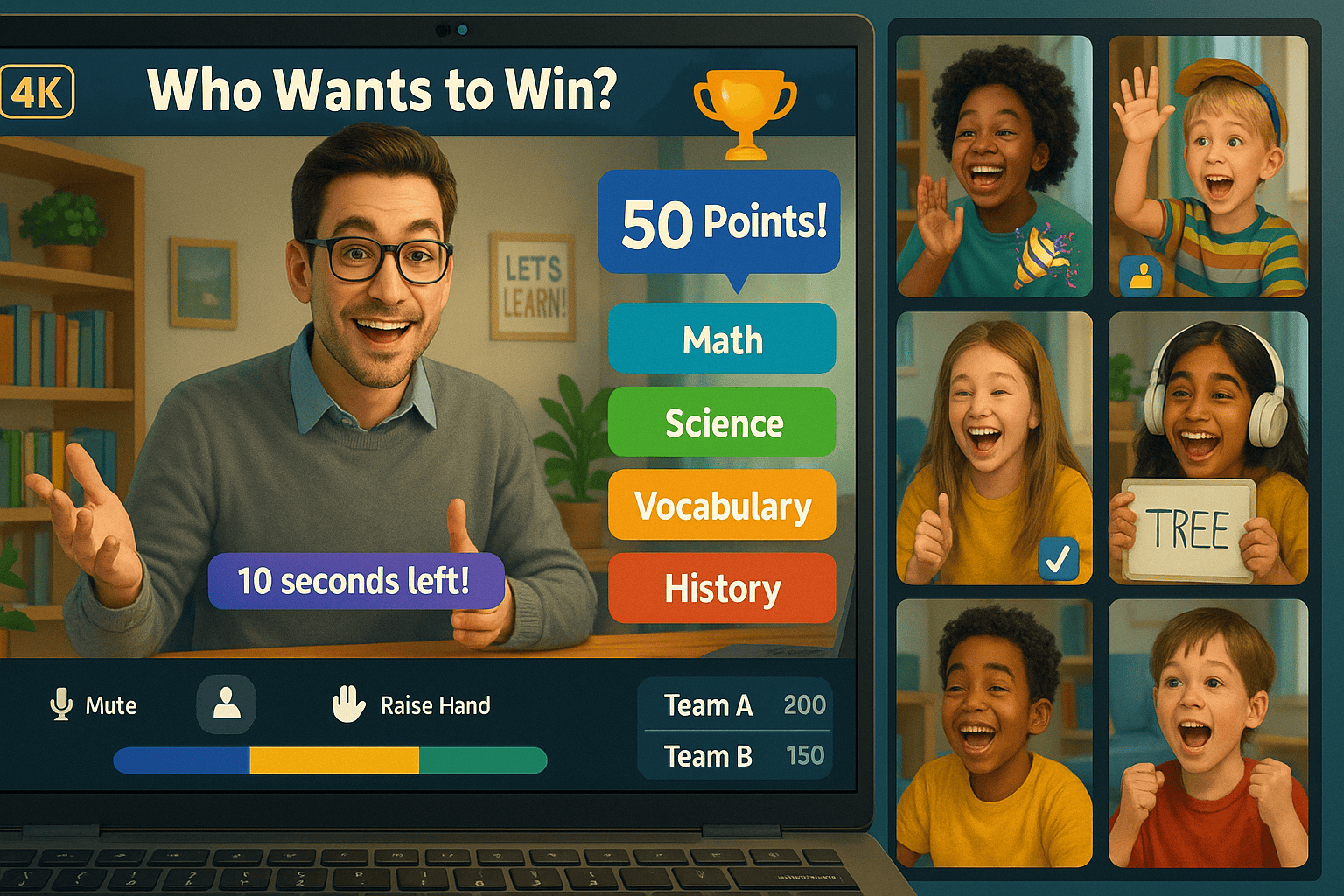15 Fun ESL Activities & Games for Teaching Kids English
Teaching English to children doesn’t have to feel like a strict lesson. With the right ESL activities for kids, teachers can make language learning feel like playtime. Kids are naturally curious, and when students play fun ESL classroom games online, they absorb new vocabulary, practice listening, and build confidence in speaking. This blog highlights 15 engaging ESL activities for kids that both younger students and more advanced students will enjoy.
Teaching English to children doesn’t have to feel like a strict lesson. With the right ESL activities for kids, teachers can make language learning feel like playtime. Kids are naturally curious, and when students play fun English learning games, they absorb new vocabulary, practice listening, and build confidence in speaking.
Why Use ESL Classroom Games and Activities for Kids?
Children learn best when they’re active, curious, and having fun. ESL teachers often find that traditional drills or grammar worksheets don’t hold attention for long. By using fun ESL classroom games, learning becomes less about memorizing rules and more about discovery.
The key benefits of ESL activities for kids are:
Encouraging students to speak without fear of making mistakes.
Helping children practice vocabulary in a fun way.
Developing teamwork and cooperation when two teams or small groups compete against each other.
Boosting spelling skills, listening, and sentence structure.
Making teaching English enjoyable for both the teacher and the students.
When students learn through fun ESL activities, they start to see English as a tool they can use daily, not just a subject.
How to Choose the Best ESL Activities for Kids
Not every ESL activity fits every classroom. To keep language learning smooth and enjoyable, ESL teachers should consider a few factors:
Age and Level
Younger students (kindergarten or early primary) often benefit from movement-based ESL games like Simon Says.
More advanced students or older ESL kids may prefer board games or word challenges.
Group Size
Some games are better for one student or two students working together.
Larger activities, like Bingo, work well for a whole class.
Learning Goals
Want to teach vocabulary? Try Pictionary or Guess the Word.
Need to strengthen grammar rules? Use grammar games like Categories.
Improving spelling skills? Word Jumble Race is a perfect match.
Classroom Setup
Ensure you have enough picture cards, word cards, or board games ready.
If using online games, make sure the tech works before starting.
Choosing wisely makes lesson planning smoother and ensures every student learns effectively.
Fun ESL Activities & English Learning Games For Children
Here are 15 ESL activities and games that work for young learners, ESL kids, and even more advanced students. Each one includes how to play, what language point it targets, and why students love it.
1. Simon Says
This classic ESL game teaches kids to follow instructions in English. The teacher says, “Simon says, touch your nose.” If the command doesn’t start with Simon says, students must not move.
Focus: Listening, beginning sounds, and action verbs.
Why kids love it: It feels like a fun way to move while learning.
For ESL teachers: A great warm-up that works well with both younger students and more advanced students.

2. Word Jumble Race
Divide the class into two teams. The teacher writes scrambled words on the board. Students race to unscramble and write the correct word.
Focus: Spelling skills, grammar rules, and new vocabulary.
Why kids love it: Competitive, fast-paced, and interactive.
Variation: Use online games for digital classrooms.

3. Hangman
Perfect for teaching vocabulary and practicing spelling skills. One student thinks of a word, others guess letters. A stick figure is drawn with each wrong guess.
Focus: English words, spelling, and critical thinking.
Why teachers love it: Reinforces new vocabulary with little prep.
Variation: Add grammar points like tenses or sentence structure.

4. Pictionary
Students play by drawing pictures of target vocabulary words while others guess.
Focus: New words, nouns, verbs, and everyday language skills.
Why kids love it: Encourages creativity and fun activities.
Variation: Use digital drawing boards for online games.

5. Charades/Mime
One student acts out a vocabulary word without speaking a word. Other students guess.
Focus: Vocabulary practice, verbs, sentence structure.
Why kids love it: A fun way to learn English while laughing.
Variation: Let advanced students act out longer phrases.

6. Hot Seat
One student sits with their back to the board while other students give clues about a hidden word.
Focus: Speaking English, listening, and teamwork.
Why teachers love it: Encourages critical thinking and practicing vocabulary.
Variation: Play in small groups for more advanced students.

7. Categories
The teacher picks a topic (e.g., animals, colors, food). Students race to write as many words as possible.
Focus: Vocabulary breadth and spelling skills.
Why kids love it: A great game to review large sets of English words.
Variation: Use grammar games to focus on tenses.
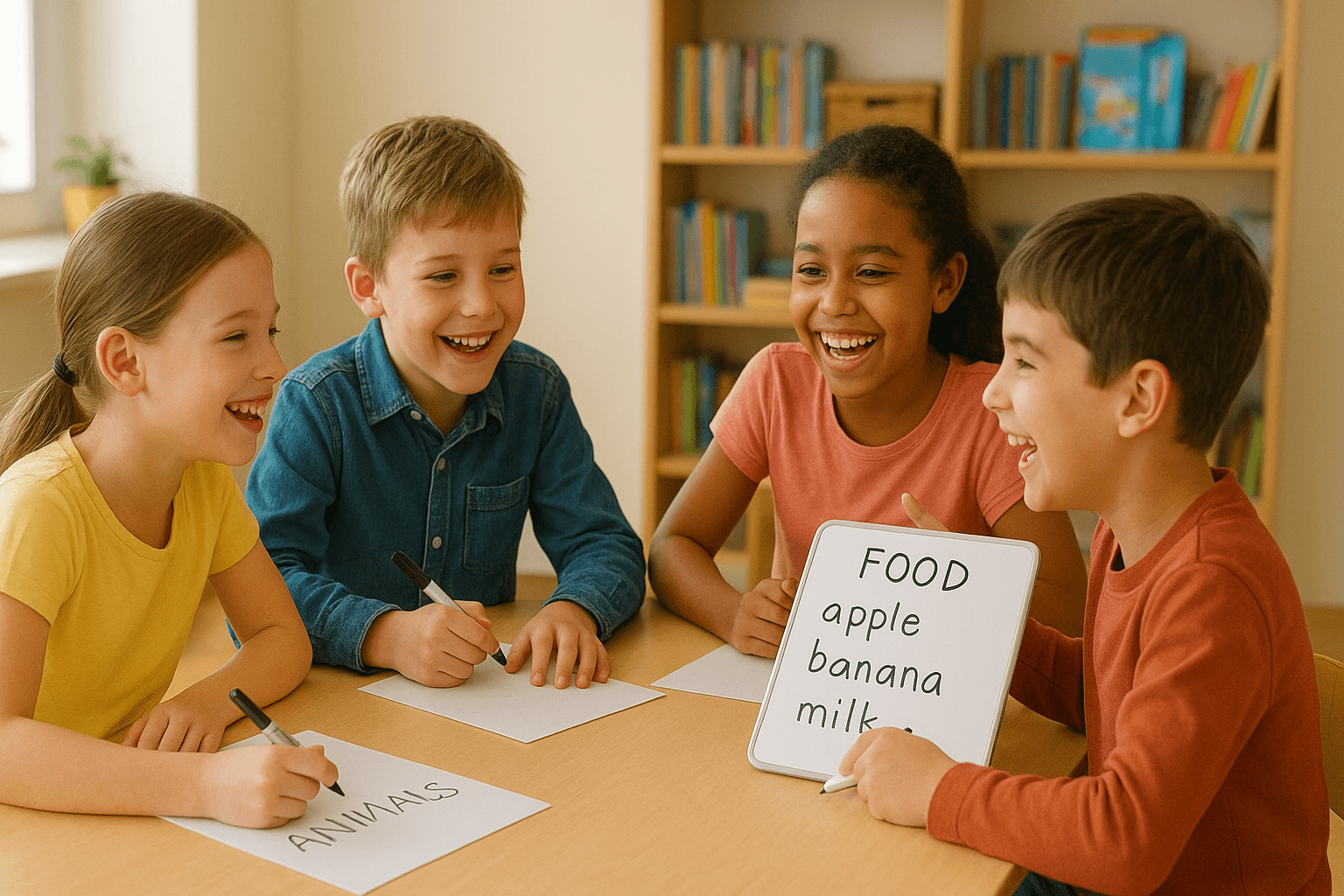
8. Bingo
ESL teachers create bingo cards with new vocabulary. The teacher calls words, and kids mark them off.
Focus: Practice vocabulary and listening skills.
Why students love it: Familiar fun game that works well with a whole class.
Variation: Play grammar bingo with sentence structure prompts.
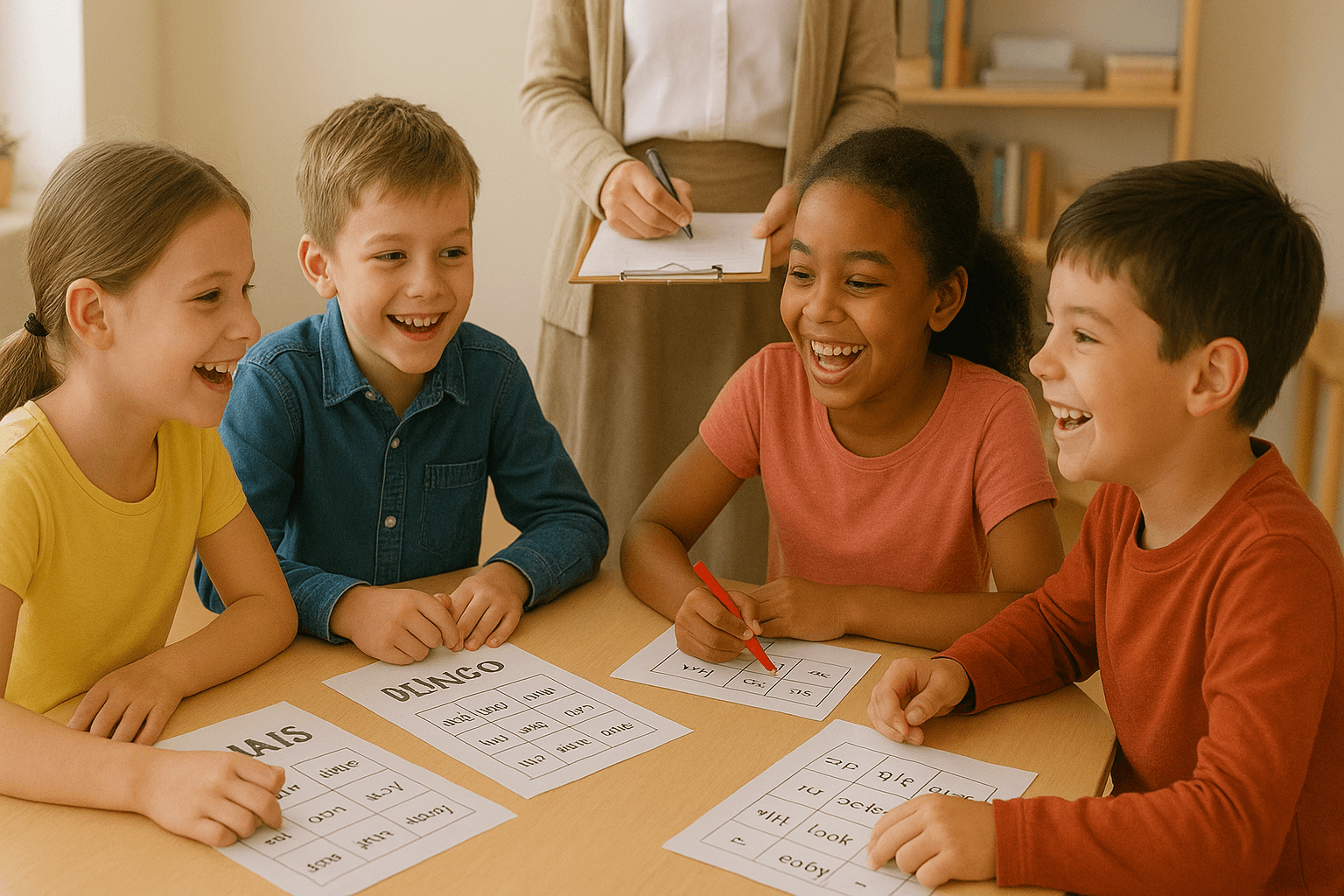
9. Alphabet Relay
Divide the class into two teams. Kids race to say or write words starting with each letter.
Focus: Spelling skills, alphabet recognition, and vocabulary practice.
Why teachers love it: Active, fun, and builds confidence.
Variation: Use board games to make it more structured.

10. Memory
Place picture cards and word cards face down. Kids turn them over to find a match.
Focus: Word recognition, new words, and recall.
Why students love it: A fun activity that feels like play.
Variation: Use grammar rules or sentence structure.
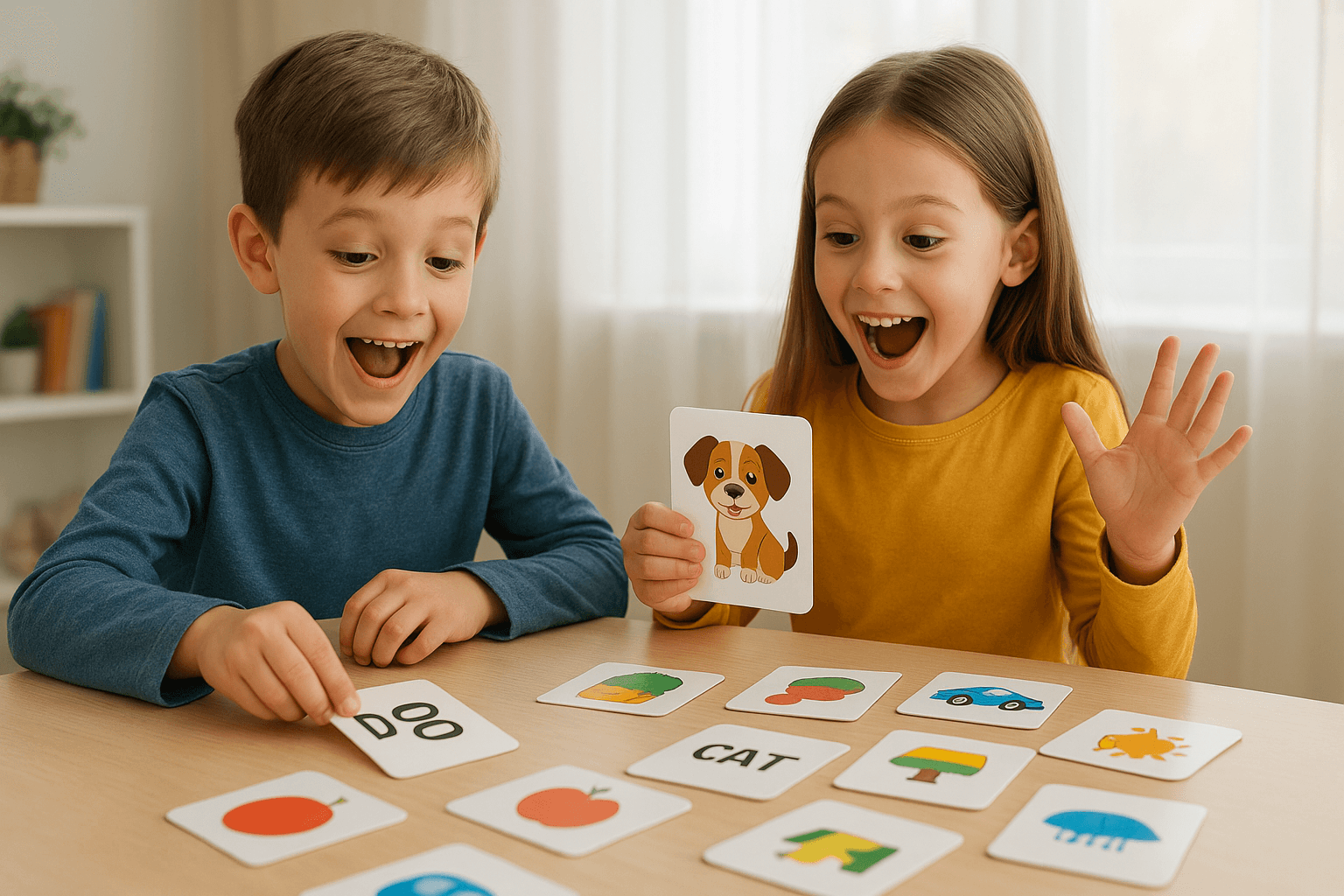
11. Telephone
A student whispers a sentence into the next student’s ear until it reaches the last student.
Focus: Listening skills, pronunciation, and sentence structure.
Why kids love it: Mistakes often yield funny and surprising results.
Variation: Use for practice grammar or new vocabulary.

12. Action Race
The teacher calls out actions, such as “Jump three times” or “Touch the board.” Students race to complete them.
Focus: Listening comprehension, spelling skills (with written commands).
Why students love it: Combines movement and fun ESL games.
Variation: Add grammar games by using tenses in commands.

13. Guess the Word/Taboo
One student describes a word without using the target vocabulary. Other students guess.
Focus: Speaking English, descriptive skills, and synonyms.
Why teachers love it: Builds fluency and critical thinking.
Variation: Use with more advanced students for complex language points.

14. What’s the Time, Mr. Wolf?
One student plays the Wolf. Others ask: “What’s the time, Mr. Wolf?” Wolf responds: “It’s 3 o’clock.” Students step forward until the Wolf says, “Dinner time!”
Focus: Numbers, telling time, and commands.
Why kids love it: Active, suspenseful, and playful.
Variation: Add grammar games like tenses.
15. Board Games
Adapt board games like Snakes and Ladders with vocabulary words or grammar rules.
Focus: Practice grammar, vocabulary, and spelling skills.
Why students love it: Feels like real play but reinforces language skills.
Variation: Have a student roll the dice and answer a question correctly to move forward.
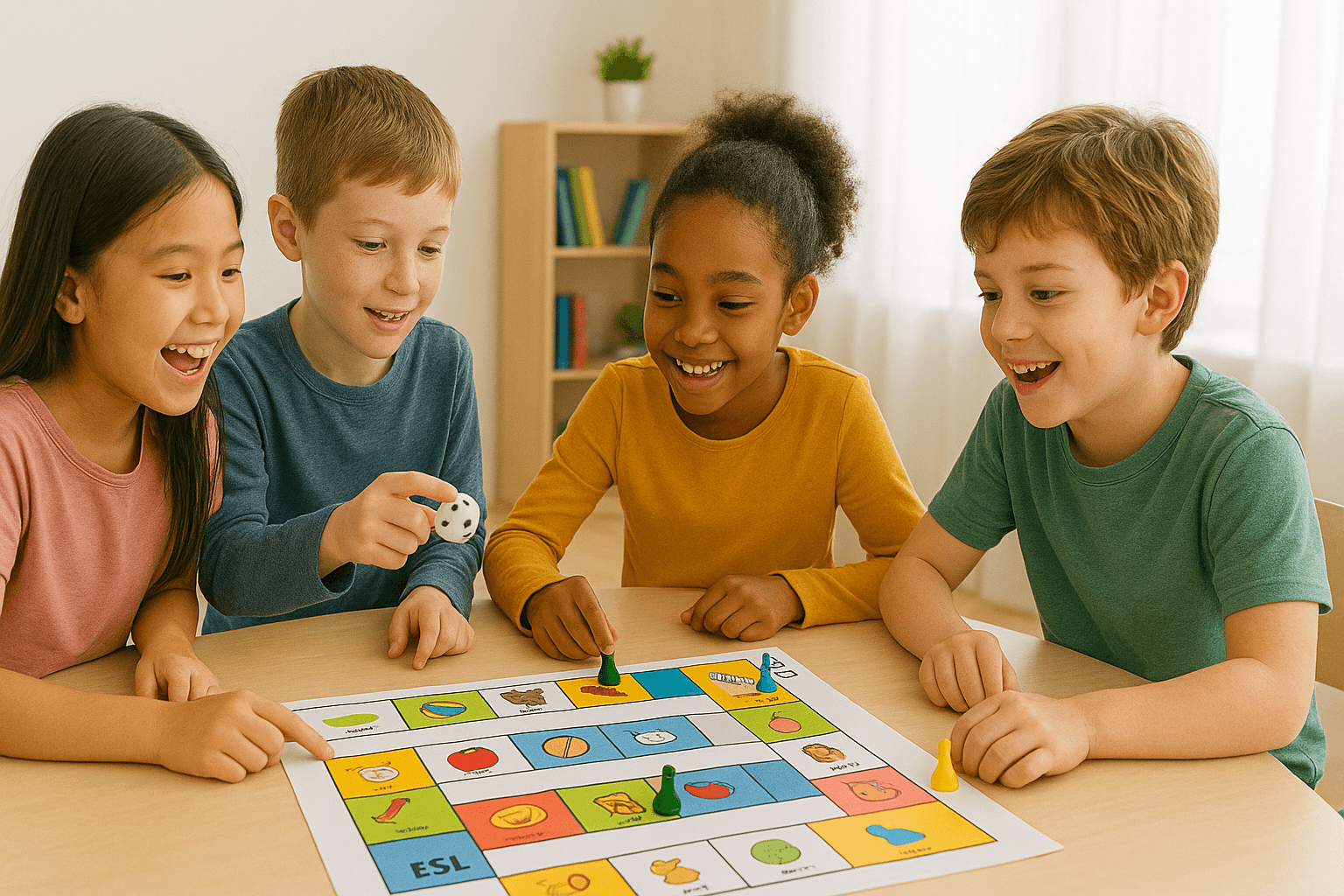
Tips for Successfully Implementing ESL Activities for Kids in Your Classroom
Keep instructions simple and show how to play: A quick demo from one student is clearer than long instructions for English language learners.
Use a mix of quiet and active games to balance energy. Switch between quiet grammar games and active ones, where students stand or move, to keep their energy level balanced.
Rotate fun activities to avoid boredom: Rotate activities so group members don’t lose interest when playing games week after week.
Use online games or digital tools for variety: Online games allow students to hold a device, making second language practice more interactive.
Encourage all group members to participate: Make space for everyone to contribute. Call on one student at a time so the whole class, not just the confident few, gets involved.
Adjust difficulty for more advanced students: If the student's level is higher, add harder vocabulary or let the other team ask more challenging questions.
Conclusion
ESL activities for kids and fun ESL classroom games make the process of learning English enjoyable, memorable, and effective. From grammar-based activities to interactive board games, each ESL activity helps students learn while reducing stress. By mixing play with structured lessons, ESL teachers can build strong language skills that last. Whether working with younger students or more advanced students, these games and activities ensure that every student learns with confidence.
Frequently Asked Questions
How can technology enhance ESL classroom games for modern learners?
Technology allows ESL teachers to adapt fun ESL classroom games into online formats, such as Quizlet or Kahoot. These digital tools make students play in interactive ways while reinforcing grammar rules, new vocabulary, and spelling skills. It also helps EFL learners practice at home.
How do English learning games for children support other academic subjects?
Games and activities don’t just build language skills. They also improve critical thinking, memory, teamwork, and confidence. These abilities transfer into subjects like math, science, and history, helping students learn beyond English words and sentence structure.
What ESL classroom games are best for large groups versus small groups?
For a whole class, Bingo, Categories, or Board Games keep everyone engaged. For small groups or two students, try Hot Seat or Taboo. This ensures all group members participate, no matter the student's level.
Are there speaking games for ESL students suitable for kids with different learning speeds?
Yes. Speaking games for students, such as Charades, Pictionary, or Telephone, allow every student to play at their own pace. Slower learners gain confidence by acting or drawing, while more advanced students can handle longer grammar rules or tougher vocabulary words.
How can parents practice ESL activities for kids at home if they don’t speak English fluently?
Parents don’t need to speak English fluently to help. Using picture cards, simple board games, or online English learning games for children with audio lets them practice language learning daily. Even reading picture books aloud builds phonological awareness, spelling skills, and confidence in a fun way.
